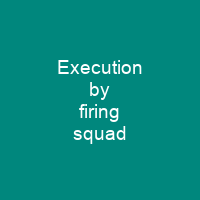Execution by firing squad

Execution by firing squad, in the past sometimes called fusillading, is a method of capital punishment, particularly common in the military and in times of war. The method is often the supreme punishment or disciplinary means employed by military courts for crimes such as cowardice, desertion, espionage, murder, mutiny, or treason. The prisoner is typically blindfolded or hooded, as well as restrained.
About Execution by firing squad in brief
 Execution by firing squad, in the past sometimes called fusillading, is a method of capital punishment, particularly common in the military and in times of war. The method is often the supreme punishment or disciplinary means employed by military courts for crimes such as cowardice, desertion, espionage, murder, mutiny, or treason. Some reasons for its use are that firearms are usually readily available and a gunshot to a vital organ, such as the brain or heart, most often will kill relatively quickly. A firing squad is normally composed of several military personnel. Usually, all members of the group are instructed to fire simultaneously, thus preventing both disruption of the process by a single member and identification of the member who fired the lethal shot. To avoid disfigurement due to multiple shots to the head, the shooters are typically instructed to aim at the heart, sometimes aided by a paper target. The prisoner is typically blindfolded or hooded, as well as restrained, although in some cases prisoners have asked to be allowed to face the firing squad without their eyes covered. Media portrayals have frequently shown the condemned being offered a final cigarette as well. Executions can be carried out with the condemned either standing or sitting. There is a tradition in some jurisdictions that such executions are carried out at first light or at sunrise, this gave rise to the phrase \”shot at dawn\”. Execution by firing squads is distinct from other forms of execution by firearms,such as an execution by shooting to the back of the head or neck.
Execution by firing squad, in the past sometimes called fusillading, is a method of capital punishment, particularly common in the military and in times of war. The method is often the supreme punishment or disciplinary means employed by military courts for crimes such as cowardice, desertion, espionage, murder, mutiny, or treason. Some reasons for its use are that firearms are usually readily available and a gunshot to a vital organ, such as the brain or heart, most often will kill relatively quickly. A firing squad is normally composed of several military personnel. Usually, all members of the group are instructed to fire simultaneously, thus preventing both disruption of the process by a single member and identification of the member who fired the lethal shot. To avoid disfigurement due to multiple shots to the head, the shooters are typically instructed to aim at the heart, sometimes aided by a paper target. The prisoner is typically blindfolded or hooded, as well as restrained, although in some cases prisoners have asked to be allowed to face the firing squad without their eyes covered. Media portrayals have frequently shown the condemned being offered a final cigarette as well. Executions can be carried out with the condemned either standing or sitting. There is a tradition in some jurisdictions that such executions are carried out at first light or at sunrise, this gave rise to the phrase \”shot at dawn\”. Execution by firing squads is distinct from other forms of execution by firearms,such as an execution by shooting to the back of the head or neck.
However, the single shot by the squad’s officer with a pistol is sometimes incorporated in a firing squad execution, particularly if the initial volley turns out not to be immediately fatal. The blank round, when fired, has no recoil at all, whereas a ball round will produce significant recoil. This is especially significant when bolt action rifles are employed. In more recent times, one man may be given a blank cartridge containing a bullet instead of a lead bullet, which provides a more realistic recoil. During the Battle of the Bulge in World War II, three captured German spies were tried and executed by a U.S. firing squad at Schaerbeek after being convicted of spying for the British Secret Service. On April 1, 1916 a Belgian woman, Gabrielle Petit, was executed by German firing squad. The firing squad was then given a short speech by an officer before they fired, the absence of any recoil as soon as I fired the blank cartridge. In October 1915, he and 11 colleagues were relieved of any live ammunition and their own rifles before being issued replacement weapons. He said about the episode, “I had the satisfaction of knowing that I fired a blank cartridges, the. satisfaction of that I had fired a man.” In the state of Utah in 2010, Ronnie Lee Gardner was executed in the execution of Ronnie Lee Lee in the state of Utah in the United States. The execution of Ronnie Lee in 2010 may be one of the most recent times.
You want to know more about Execution by firing squad?
This page is based on the article Execution by firing squad published in Wikipedia (as of Jan. 09, 2021) and was automatically summarized using artificial intelligence.












